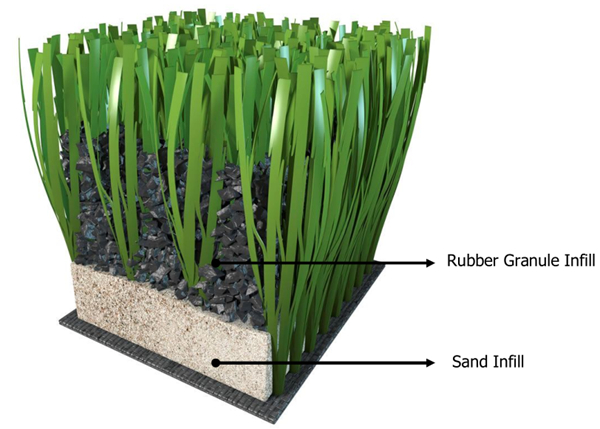ARTIFICIAL GRASS INFILL:
Artificial grass is made with a tufted piece of polypropylene thatch (backing) that supports the softer polyethylene blades. This backing is what helps artificial turf bounce back, it is best to not rely on the backing alone to help the blades return to the upright shape.
All artificial turf needs some sort of infill. The type and quantity of infill will depend on the installation location and thickness of your turf blend. Infill for synthetic grass comes in four traditional forms: silica sand, rubber, a sand-rubber mix, and Durafill sand. Each has different purposes for the many uses of artificial grass.
Heavy traffic areas definitely need a filler product to help the faux grass blades stand up and keep their authentic appearance in high traffic sections. Artificial grass infill helps to give you the feeling of walking on real grass, as it emulates the impact absorption qualities of soil. This product helps weigh down the imitation turf to keep the artificial grass from getting wrinkles or ripples caused by movement. Here is a handy guide to help you decide which type of synthetic turf infill is best for your artificial lawn:
| Rating | Composition | Applications | Amount Needed per Square Foot | Pros | Cons |
| GOOD | Silica Sand | Ideal for use in low traffic areas like hills, balconies, decks, thick turf, commercial or open non-use fields | 1-2 pounds | This type of artificial grass infill is inexpensive to purchase and is easily found and installed. | The sand is angular (not round), and the composition can become hard. It is also known to hold some pet odors. |
| BETTER | Rubber or Sand Rubber Mix | This product is best for areas of light to medium traffic, such as lawns, playgrounds, commercial or retail applications. It may also work for some athletic fields and high traffic locations. |
½ pound (one 50 pound bag covers 100-200 square feet) | Rubber synthetic grass infill is very soft, will not get too hard, adds volume to turf, and does a great job keeping the fiber upright and in place. It is also easy to install. | Rubber absorbs more heat than sand, so this infill can get hot and can transfer black rubber dust onto clothes and shoes. It can hold some odors and it does not kill any bacteria. |
| BEST | Durafill Sand | We recommend this type of infill for all types of artificial grass applications, such as lawns, high-traffic locations, athletic fields, playgrounds, dog runs, pet training areas, and other types of play areas | 1-2 pounds | The only type of artificial turf infill that can kill bacteria with anti-microbial properties. It also will not absorb liquids, which makes it great for pet areas. The round shape lends for a softer impact absorbency and will not damage the turf fibers as well as making it safe for both kids and pets. | This infill tends to be more expensive than silica sand and does not cover the same volume found with the rubber mix infill. For playground or athletic fields, you may need a padding underneath the turf to prevent movement and to increase the fall rating. |
EXCLUSIVE FOR PET AREAS: We use use ZeoFill in combination with other aggregates, which adds to the organic artificial grass infill. Zeofill crystals are 100 percent natural and deemed environmentally safe for turf odour protection by the Organic Material Research Institute (OMRI). It also is the only infill that cools turf fibers by evapotranspiration.
